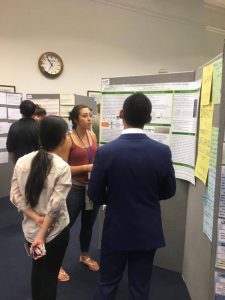Today the first item on my agenda was a trip to the biomaterials lab at the Imperial College in London. We started off with a quick lecture on bio-engineering and the use of engineered scaffolds for controlled cell growth, then had a tour of the lab where there were post-docs working on a variety of different projects. The labs at Imperial are supposedly some of the richest labs in England. So of course, they were absolutely beautiful and made me unbelievably jealous. We saw some fantastic work being done in the lab with a group focus on disease diagnostics and treatment. Projects ranged from nanoparticle treatments for malaria, to using Raman IR lasers for cancer diagnosis, to growing cardiac cells from de-differentiated cells on a specially designed hydro-gel scaffolds. My personal favourite was a post-doc project being completed by Dr. James Armstrong, where he was working on cell alignment using ultrasound waves. He created standing waves using ultrasound electrodes and was able to move cells sitting randomly in media into parallel lines which could then be applied to a scaffold and grown into tissue that requires linear alignment. The idea of using ultrasonic waves to move cells is such a brilliant idea and not one that seems obvious at first, but makes a fair bit of sense once you start thinking about it. I have never been so enthralled and inspired by science as I was seeing the cells move into line! We weren’t able to take photos or videos in the lab, but the result was almost instantaneous cell movement and was very impressive. (What a science nerd I am).
For more information on the Biomaterials group, visit http://www.stevensgroup.org/index.php/site . I would highly recommend checking out the research, it is really fantastic work.
After the lab visit we had an eye opening lecture on vision and the neural systems involved in sight recognition and processing, then got ready for poster presentations. I presented my poster and had the opportunity to talk to some other students at the Bazaar as well. The level of research being performed, even at the high school level, was astounding. Highlights include a student from Barcelona studying a genetic heart defect in a family and identifying the point mutation responsible for the defect, an Italian who designed a low cost air monitoring device which he designed in his basement, and a student from the USA who identified a pattern of CpG methylation (DNA methylation) which could be used for leukemia diagnosis.
After posters, I enjoyed talking to a Swedish girl who had just visited British Columbia with her dad. We reminisced about the fruit in BC and how wonderful it would be to have some here. She told me we have the best apples in the world (Ambrosias) and about the wonderful raspberries and blueberries that they have in Sweden and it made us rather hungry and homesick.
It was wonderful to be reminded of home though and to hear that she had enjoyed visiting BC so much!
Talk soon, T.


